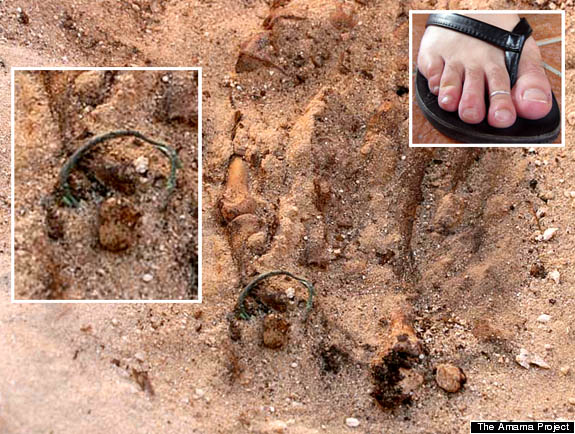Were Copper Toe Rings A Male Fashion Statement In Egypt 3,300 Years Ago?
By: Kelly York
Archaeologists have evidence that men in ancient Egypt wore copper alloy toe rings more than 3,300 years ago. What is still a mystery, however, is whether the rings were worn as fashion statements or magical healing devices.
 In a study published in the Journal of Egyptian Archaeology, members of the Amarna Project reported the discovery of two Egyptian skeletons, each adorned with a toe ring made of copper alloy. This was the first time archaeologists had ever seen toe rings of that material linked to ancient Egyptians.
The archaeologists believe the toe rings were likely worn while the individuals were still alive, but the purpose of the rings is the subject of a hot debate.
Although it’s possible that the toe rings were simply used for body adornment, the condition of one of the skeletons points to another conclusion.
In a study published in the Journal of Egyptian Archaeology, members of the Amarna Project reported the discovery of two Egyptian skeletons, each adorned with a toe ring made of copper alloy. This was the first time archaeologists had ever seen toe rings of that material linked to ancient Egyptians.
The archaeologists believe the toe rings were likely worn while the individuals were still alive, but the purpose of the rings is the subject of a hot debate.
Although it’s possible that the toe rings were simply used for body adornment, the condition of one of the skeletons points to another conclusion.
 One skeleton had suffered a fractured foot and broken left femur, which led some researchers to surmise that the toe ring on the damaged left foot may have been worn to heal the injuries.
“The act of binding or encircling was a powerful magical device in ancient Egypt, and a metal ring, which can be looped around something, lends itself well to this kind of action,” Anna Stevens, the assistant director of the Amarna Project, told LiveScience.com.
Supporting the claim that the toe ring was a fashion statement is the second skeleton that had no visible injuries. Stevens noted that this individual has yet to be studied in depth by bio-archaeologists and its sex is unknown.
One skeleton had suffered a fractured foot and broken left femur, which led some researchers to surmise that the toe ring on the damaged left foot may have been worn to heal the injuries.
“The act of binding or encircling was a powerful magical device in ancient Egypt, and a metal ring, which can be looped around something, lends itself well to this kind of action,” Anna Stevens, the assistant director of the Amarna Project, told LiveScience.com.
Supporting the claim that the toe ring was a fashion statement is the second skeleton that had no visible injuries. Stevens noted that this individual has yet to be studied in depth by bio-archaeologists and its sex is unknown.
 The Amarma Project team unearthed the skeletons in a cemetery just south of the ancient city of Akhetaten, which was a short-lived Egyptian capital built by Pharaoh Akhetaten, the presumed father of the famous Tutankhamun (King Tut).
More information on the Amarna Project can be found at www.amarnaproject.com.
The Amarma Project team unearthed the skeletons in a cemetery just south of the ancient city of Akhetaten, which was a short-lived Egyptian capital built by Pharaoh Akhetaten, the presumed father of the famous Tutankhamun (King Tut).
More information on the Amarna Project can be found at www.amarnaproject.com.
 Visit Ben David Jewelers on Facebook
Visit BenDavidJewelers.com
Visit Ben David Jewelers on Facebook
Visit BenDavidJewelers.com
 In a study published in the Journal of Egyptian Archaeology, members of the Amarna Project reported the discovery of two Egyptian skeletons, each adorned with a toe ring made of copper alloy. This was the first time archaeologists had ever seen toe rings of that material linked to ancient Egyptians.
The archaeologists believe the toe rings were likely worn while the individuals were still alive, but the purpose of the rings is the subject of a hot debate.
Although it’s possible that the toe rings were simply used for body adornment, the condition of one of the skeletons points to another conclusion.
In a study published in the Journal of Egyptian Archaeology, members of the Amarna Project reported the discovery of two Egyptian skeletons, each adorned with a toe ring made of copper alloy. This was the first time archaeologists had ever seen toe rings of that material linked to ancient Egyptians.
The archaeologists believe the toe rings were likely worn while the individuals were still alive, but the purpose of the rings is the subject of a hot debate.
Although it’s possible that the toe rings were simply used for body adornment, the condition of one of the skeletons points to another conclusion.
 One skeleton had suffered a fractured foot and broken left femur, which led some researchers to surmise that the toe ring on the damaged left foot may have been worn to heal the injuries.
“The act of binding or encircling was a powerful magical device in ancient Egypt, and a metal ring, which can be looped around something, lends itself well to this kind of action,” Anna Stevens, the assistant director of the Amarna Project, told LiveScience.com.
Supporting the claim that the toe ring was a fashion statement is the second skeleton that had no visible injuries. Stevens noted that this individual has yet to be studied in depth by bio-archaeologists and its sex is unknown.
One skeleton had suffered a fractured foot and broken left femur, which led some researchers to surmise that the toe ring on the damaged left foot may have been worn to heal the injuries.
“The act of binding or encircling was a powerful magical device in ancient Egypt, and a metal ring, which can be looped around something, lends itself well to this kind of action,” Anna Stevens, the assistant director of the Amarna Project, told LiveScience.com.
Supporting the claim that the toe ring was a fashion statement is the second skeleton that had no visible injuries. Stevens noted that this individual has yet to be studied in depth by bio-archaeologists and its sex is unknown.
 The Amarma Project team unearthed the skeletons in a cemetery just south of the ancient city of Akhetaten, which was a short-lived Egyptian capital built by Pharaoh Akhetaten, the presumed father of the famous Tutankhamun (King Tut).
More information on the Amarna Project can be found at www.amarnaproject.com.
The Amarma Project team unearthed the skeletons in a cemetery just south of the ancient city of Akhetaten, which was a short-lived Egyptian capital built by Pharaoh Akhetaten, the presumed father of the famous Tutankhamun (King Tut).
More information on the Amarna Project can be found at www.amarnaproject.com.
